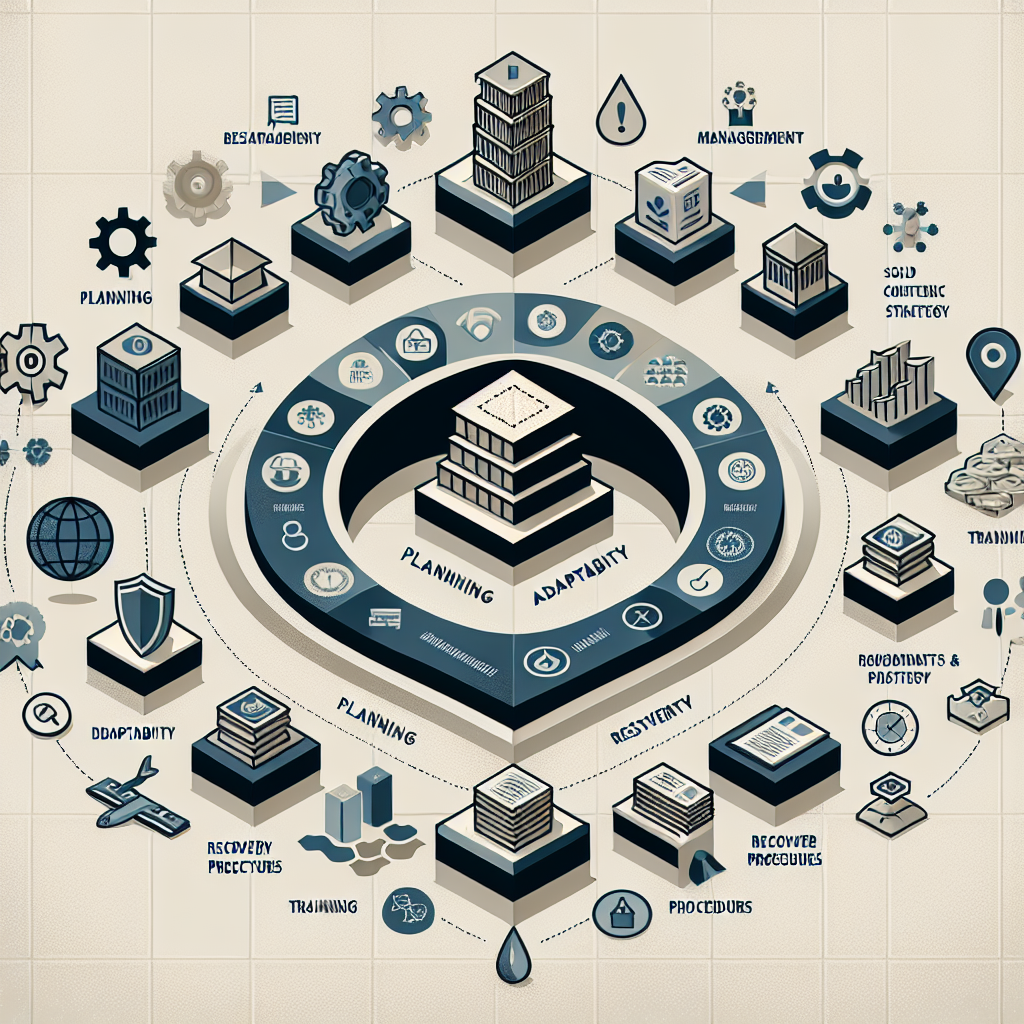Your cart is currently empty!
Tag: Strategy

Choosing the Right Data Backup and Recovery Strategy for Your Business
In today’s digital age, data is at the heart of every business operation. From customer information to financial records, businesses rely on data to make informed decisions and drive growth. However, data is vulnerable to various threats, such as cyberattacks, natural disasters, and human error. Therefore, having a robust data backup and recovery strategy is essential to ensure business continuity and protect valuable information.When it comes to choosing the right data backup and recovery strategy for your business, there are several factors to consider. Here are some key considerations to keep in mind:
1. Identify your data backup needs: Before selecting a backup solution, it’s essential to assess your data storage requirements. Consider the volume of data you need to back up, the frequency of backups, and the level of protection required for different types of data. By understanding your data backup needs, you can choose a solution that aligns with your business requirements.
2. Evaluate different backup options: There are various data backup options available, including on-site, off-site, and cloud-based solutions. On-site backups involve storing data on physical devices located on-premises, while off-site backups involve storing data at a remote location. Cloud-based backups, on the other hand, involve storing data in the cloud, providing scalability and accessibility from anywhere. Evaluate the pros and cons of each option to determine which best suits your business needs.
3. Consider data recovery capabilities: In addition to backup, it’s crucial to consider data recovery capabilities when choosing a data backup solution. A reliable data recovery strategy should include features such as data encryption, versioning, and automated recovery processes. Ensure that your chosen backup solution offers robust data recovery capabilities to minimize downtime and data loss in the event of a disaster.
4. Ensure data security and compliance: Data security and compliance are paramount when selecting a data backup and recovery strategy. Ensure that your chosen solution adheres to industry standards and regulations, such as GDPR and HIPAA, to protect sensitive information and maintain regulatory compliance. Additionally, implement security measures, such as encryption and access controls, to safeguard your data from unauthorized access.
5. Test and monitor your backup solution: Once you have implemented a data backup and recovery strategy, it’s essential to regularly test and monitor its effectiveness. Conduct routine backup tests to ensure that your data is being backed up correctly and can be recovered in the event of a disaster. Monitor backup processes and performance metrics to identify any issues and make necessary adjustments to improve data protection.
In conclusion, choosing the right data backup and recovery strategy for your business is crucial to safeguard valuable information and ensure business continuity. By identifying your data backup needs, evaluating different backup options, considering data recovery capabilities, ensuring data security and compliance, and testing and monitoring your backup solution, you can create a robust data protection strategy that meets your business requirements. Invest in a reliable data backup solution today to protect your business data and mitigate the risks of data loss.

Proactive Maintenance: A Smart Strategy for Keeping Equipment Running Smoothly
Proactive Maintenance: A Smart Strategy for Keeping Equipment Running SmoothlyIn any industry that relies on heavy machinery and equipment, ensuring that these assets are operating smoothly and efficiently is crucial for productivity and profitability. One way to achieve this is through proactive maintenance, a strategy that involves regularly monitoring and servicing equipment before any major issues arise.
Proactive maintenance is a preventive approach to equipment maintenance that focuses on identifying and addressing potential problems before they escalate into costly breakdowns or downtime. By implementing a proactive maintenance program, businesses can avoid unexpected repairs, reduce the risk of equipment failure, and extend the lifespan of their assets.
There are several key components to a successful proactive maintenance program. The first step is to establish a regular schedule for equipment inspections and servicing. This can involve routine tasks such as lubricating moving parts, checking for wear and tear, and calibrating sensors and controls. By staying on top of these maintenance activities, businesses can catch potential issues early on and address them before they escalate.
Another important aspect of proactive maintenance is the use of predictive technologies, such as vibration analysis, infrared thermography, and oil analysis. These tools can help businesses detect early signs of equipment wear and tear, allowing them to take corrective action before a breakdown occurs. By leveraging these technologies, businesses can improve the reliability and performance of their equipment while minimizing the risk of unexpected failures.
In addition to regular inspections and predictive technologies, proactive maintenance also involves implementing a robust maintenance management system. This system can help businesses track equipment performance, schedule maintenance tasks, and store relevant documentation and records. By centralizing maintenance activities and data, businesses can improve their overall maintenance practices and ensure that equipment is properly serviced and maintained.
Overall, proactive maintenance is a smart strategy for keeping equipment running smoothly and efficiently. By proactively monitoring and servicing equipment, businesses can avoid costly breakdowns, reduce downtime, and extend the lifespan of their assets. With the right tools, technologies, and management systems in place, businesses can create a proactive maintenance program that delivers tangible benefits and helps them stay ahead of potential equipment issues.

Key Components of a Successful Business Continuity Strategy
In today’s fast-paced and unpredictable business environment, it is essential for companies to have a solid business continuity strategy in place. This strategy helps organizations to prepare for and recover from potential disruptions, such as natural disasters, cyber attacks, or other emergencies, minimizing the impact on operations and ensuring business continuity.There are several key components that are essential for a successful business continuity strategy. These components are crucial for ensuring that a company can effectively respond to and recover from disruptions, maintaining operations and minimizing downtime.
1. Risk Assessment: The first step in developing a business continuity strategy is conducting a thorough risk assessment. This involves identifying potential risks and vulnerabilities that could impact the business, such as natural disasters, supply chain disruptions, or cyber threats. By understanding these risks, companies can develop strategies to mitigate them and ensure business continuity.
2. Business Impact Analysis: Once risks have been identified, it is important to conduct a business impact analysis. This involves assessing the potential impact of disruptions on key business processes and functions. By understanding the potential consequences of disruptions, companies can prioritize their response efforts and allocate resources effectively.
3. Business Continuity Plan: A business continuity plan is a comprehensive document that outlines the steps to be taken in the event of a disruption. This plan should include strategies for responding to emergencies, communication protocols, and recovery procedures. It should also outline roles and responsibilities for key personnel and specify resources needed to implement the plan.
4. Communication Plan: Effective communication is essential during a crisis situation. A communication plan should outline how information will be shared with employees, customers, suppliers, and other stakeholders during a disruption. This plan should include contact information for key personnel, communication channels to be used, and protocols for updating stakeholders on the status of operations.
5. Testing and Training: It is important to regularly test and update the business continuity plan to ensure its effectiveness. This may involve conducting tabletop exercises or simulations to practice response procedures and identify areas for improvement. Additionally, employees should receive training on their roles and responsibilities during a crisis to ensure a coordinated and effective response.
6. Continual Improvement: Business continuity planning is an ongoing process that requires continual assessment and improvement. Companies should regularly review and update their strategies in response to changing risks and business needs. This may involve updating the risk assessment, revising the business impact analysis, or refining response procedures based on lessons learned from previous incidents.
In conclusion, a successful business continuity strategy is essential for ensuring that companies can effectively respond to and recover from disruptions. By incorporating key components such as risk assessment, business impact analysis, a business continuity plan, communication plan, testing and training, and continual improvement, organizations can enhance their resilience and minimize the impact of disruptions on their operations. Investing in a robust business continuity strategy is crucial for safeguarding the continuity and success of a business in today’s volatile business environment.

How to Improve Customer Satisfaction with an Effective Help Desk Strategy
Customer satisfaction is crucial for the success of any business. A happy customer is more likely to become a loyal customer and advocate for your brand. One of the key ways to improve customer satisfaction is by having an effective help desk strategy in place.Here are some tips on how to improve customer satisfaction with an effective help desk strategy:
1. Provide timely and personalized responses: Customers expect quick and personalized responses when they reach out for help. Make sure your help desk team is trained to respond to customer inquiries promptly and in a personalized manner. This can help build trust and improve customer satisfaction.
2. Use the right technology: Investing in the right help desk software can make a big difference in improving customer satisfaction. Choose a platform that allows you to easily track and manage customer inquiries, automate responses, and provide self-service options. This can help streamline your support process and make it more efficient for both your team and your customers.
3. Empower your help desk team: Your help desk team is on the front lines of customer support, so it’s important to empower them with the tools and resources they need to do their job effectively. Provide ongoing training and support, encourage collaboration and communication, and recognize and reward their hard work. A happy and motivated help desk team can have a big impact on customer satisfaction.
4. Gather feedback and make improvements: To ensure your help desk strategy is effective, it’s important to gather feedback from customers and use that information to make improvements. Encourage customers to provide feedback after each interaction, and use that feedback to identify areas for improvement. Making continuous improvements to your help desk strategy can help you better meet the needs and expectations of your customers.
5. Monitor performance metrics: Monitoring key performance metrics can help you track the effectiveness of your help desk strategy and identify areas for improvement. Keep an eye on metrics such as response time, resolution time, customer satisfaction scores, and ticket volume. Use this data to identify trends, make adjustments to your strategy, and ensure you’re providing the best possible support to your customers.
In conclusion, having an effective help desk strategy is essential for improving customer satisfaction. By providing timely and personalized responses, using the right technology, empowering your help desk team, gathering feedback, and monitoring performance metrics, you can create a positive and efficient support experience for your customers. Ultimately, a satisfied customer is more likely to become a loyal customer and advocate for your brand.
Civilization 7 review: “A revolutionary strategy game that cements the series’ legendary status”
War. Colonization. Atomic bombs. I know these things are bad. But if there’s one thing I hate more than nuclear hellfire, it’s losing in games – so when Firaxis’ latest turn-based strategy Civilization 7 dangles these options in front of me as a means of beating slimy Ben Franklin and his diplomacy-loving ways, I gobble up its sinful platter like the greedy little war criminal I am.
Civilization 7 brings a lot to the table, and not all of it requires abandoning your morality to play with. Fans of the series will find a map that’s livelier than ever, city management that won’t overload your brain, and one of the most engaging endgames ever devised. While predecessor Civilization 6 crammed in similar depth without quite managing to convey all of it clearly, Civilization 7 feels like a cohesive next step for the franchise – and when a few quirks are ironed out, this will be the series’ best modern iteration to date.
Next turn

(Image credit: Firaxis) Fast facts
Release date: February 11, 2025
Platform(s): PC, PS5, PS4, Xbox Series X|S, Xbox One, Nintendo Switch
Developer: Firaxis
Publisher: 2KWhether you’re a returning fan or stepping into Firaxis’ iconic 4X (exploration, expansion, exploitation, and extermination) strategy series for the first time, Civilization’s core premise remains largely the same. Starting with one settlement, you’ll grow your empire across a randomly-generated world with the goal of seizing victory through scientific, cultural, militaristic, or economic means. It’s a tried-and-true formula, but Civilization 7 takes a couple of big risks that shake it up creatively.
The first thing you’ll notice is that you no longer pick a Civilization and get to work. Instead you choose a leader – who remains with you through an entire campaign – while your Civilization choice changes at several points based on your playstyle and leader’s historical background. Rolling with Confucius, for example, opens up Ming China as an option, due to his real-world background, but with multiple iron mines in the bag, I could also go Norman.
I was worried this feature would dilute the identity of factions, but that’s not the case. Rather than picking a civilization with a unique unit that’s obsolete 50 turns in (or one that doesn’t turn up for another 200) you now get to pick a total of three civs that are relevant for their entire duration, all with the nifty perks and special units you would expect from past Civ games.
Likewise, I’ve been dreading how Ages would work since Civilization 7’s reveal. Since the ’90s, Civilization’s whole deal has been unleashing players in a sandbox and letting them do their thing (see: war crimes) uninterrupted. Now, each match is divided into three segments – the opening Antiquity Age, followed by Exploration, and finally Modern.
It’s not always a smooth transition, as each Age has a hard stop that resets the board a little. This is particularly frustrating if you’re in the middle of something important. In one match, I was closing in on the end of a particularly bloody war and within reach of my mortal enemy Amina’s capital when the Age shifted from Exploration to Modern, ending our war and warping my soldiers back to my own distant territories. The rancid cherry on top? Some of the no-name civs who were trailing on the leaderboard got a major science boost through the interim, meaning my empire was promptly invaded by landships while its citizens were still marveling at the wonders of the wooden wheel.

(Image credit: Firaxis) That’s not an indictment, though. Since then, I’ve realized that it takes time to learn how Ages work. In previous entries you’d slowly build strength through the course of each game – conquering capital cities, hurtling towards space flight, or hoarding cultural wonders like a well-read toddler – until it all came to a head. In Civilization 7 victory is more measured, and to carry your momentum through to the next Age you need to complete Legacy Paths: a series of win conditions for each individual age, rewarding permanent bonuses. If you want to win through science, for instance, you’ll start by rushing to build libraries and academies in Antiquity, prioritize housing specialists in your cities through Exploration, and finally try to be the first civ in space during Modern. Doing so lets you carry powerful perks across Ages, whilst neglecting them is a surefire way to fall behind.
I’ve got mixed feelings. Legacy Paths and Ages make the early and mid-game feel a lot more dynamic, and freshen up a campaign’s later stages. But at times it feels like you’re being railroaded into one path – a little jarring, given the freedom of Civ’s sandbox approach up to this point. Although I’d like to see more objective varieties or pathways through these Legacy Paths, I do think that Ages (even if they’re a little heavy-handed) are an improvement to the formula, if only because the endgame is no longer ticking boxes until you reach a surefire win.
I’ll stay right here

(Image credit: Firaxis) When all of that clicks, Civilization 7 is a thrill. Outside of the big gambles, the core Civilization experience is lightyears ahead of anything we’ve seen from the series before. Moving from one turn to the next is near-instantaneous, and besides the world looking sublime with its visual glow-up and warmer palette, it feels livelier than ever. Volcanic eruptions change surrounding tiles, rivers flood, and powerful storms can wreak havoc. I nearly missed out on colonizing a new continent (boo-hoo, I know) because a huge hurricane kicked up as my army was crossing the ocean, gaining on their ships as I furiously fear-hammered movement commands to reach the coast.
That liveliness extends to combat’s impressive fluidity. Army commanders allow you to stack units and transport them around in-sync, and can order simultaneous attacks that are worth utilizing – having every archer in range fire at once gives each unit involved more combat strength, for example, but you can also command mass pillaging or have everyone construct makeshift fortifications on their tiles.
During my first campaign as Xerxes, a three-way war with my continental neighbors Machiavelli and Himiko drew the attention of meddling outsiders Ben Franklin and Ashoka, World Renouncer. The latter two factions had no settlements in the continent, but decided to wade in anyway, landing masses of tanks and gun-toting infantry on our shores and transforming the countryside into a fiery wreck until I turned the sea into a killing field of my own with a blockade of battleships. I’ve sunk hundreds of hours into Civilization, but that single conflict is the most fun I’ve ever had with combat.
All’s fair

(Image credit: Firaxis) Strong Influence

(Image credit: Firaxis Games) Independent powers – a new cross of barbarians and city states – can churn out hostile soldiers early on. You’ll have to stock up troops of your own, or burn through Influence (Civ 7’s new take on diplomacy) to deal with them.
Commodifying diplomacy is an interesting choice (see Strong Influence). Firaxis has long tried to play around the fact that AI motivations can be inscrutable, and reducing it to a resource is an inelegant but mostly effective solution. Besides using it to push trade, scientific, and commercial agreements with other civs, Influence can boost your support for a war back home – whichever side of the battle has lower support takes some pretty harsh penalties in combat, so it’s important to keep the troops happy. But it’s also a step back in some ways, as gold can no longer be used to tantalize other civs into settling wars, and you can’t buy or sell settlements.
This is particularly frustrating because razing settlements in war permanently penalizes your war support for every future conflict, which means that since you also can’t milk your rival for gold during peace negotiations, you sometimes have to absorb rubbish settlements rather than burn them to the ground. That in itself is another can of worms, as Civilization 7 goes big on expansion. Settlements are now divided into towns and cities, with the former acting as lower-maintenance support hubs for your cities.
All of that, paired simpler iteration of Civilization 6’s district system, means juggling your empire is far less of a headache. Because there are fewer penalties to expanding, you (and AI factions) tend to manage significantly more settlements. Finding unclaimed land is now genuinely scrappy, and racing to plant my flag in undeveloped continents has been the highlight of my time in Civilization 7. I’ve admittedly found myself engaging with the cultural side of Civ less because of it, though, and AI has an irritating habit of squeezing a town right outside of your established borders.
I had no idea what to expect from Civilization 7. Firaxis has a habit of scaring fans by announcing wild choices (hello, Marvel’s Midnight Suns) then pulling them off so slickly you forget there was ever any doubt. Civilization 7 isn’t quite so slick – with its heavy-handed Ages diplomacy rework – but it’s certainly a huge stride forward for the legendary strategy series, joining the clarity of Civilization 5 with the added depth of Civilization 6.
Ages will be more divisive – I personally think the system does wonders for the usual tedium of late-stage campaigns – while other features, like pairing Leaders with evolving civs, should be a staple going forward. Civilization 7 already feels like the best entry point yet, and with Firaxis’ habit of saving the real polish for expansions, I think this is going to become a grand strategy titan. Just keep an eye on that Ben Franklin fella – and don’t believe a word he says about any “war crimes”.
Civilization 7 was reviewed on PC, with a code provided by the publisher.
Whether you prefer turn-based or real-time map-painters, here are the best strategy games you should check out
Civilization 7 Review: A revolutionary strategy game that cements the series’ legendary statusAs a long-time fan of the Civilization series, I was eagerly anticipating the release of Civilization 7. And let me tell you, it did not disappoint. This latest installment in the beloved franchise is a true masterpiece, offering a level of depth and complexity that is unmatched by any other strategy game on the market.
One of the first things you’ll notice about Civilization 7 is the stunning visuals. The game looks absolutely gorgeous, with detailed landscapes, vibrant colors, and realistic animations that bring the world to life. The attention to detail is truly impressive, and it’s clear that a lot of care and effort went into creating this game.
But visuals aside, what really sets Civilization 7 apart is its gameplay. The core mechanics of the series are still present – you’ll still be building cities, researching technologies, and engaging in diplomacy with other civilizations. But Civilization 7 takes things to a whole new level with the introduction of new features and mechanics that add depth and complexity to the gameplay.
One of the most notable additions is the new cultural system, which allows you to influence the culture of your civilization and shape its identity. This adds a whole new layer of strategy to the game, as you’ll need to carefully balance your cultural output with your military and economic goals.
Another standout feature is the revamped diplomacy system, which offers more options for interacting with other civilizations than ever before. You can now form alliances, trade resources, and even engage in espionage to gain an advantage over your rivals. The AI has also been improved, making for more challenging and engaging gameplay.
Overall, Civilization 7 is a true masterpiece that cements the series’ legendary status. It’s a must-play for fans of strategy games, and a worthy addition to the Civilization franchise. If you’re looking for a game that will challenge your mind and keep you coming back for more, look no further than Civilization 7.
Tags:
Civilization 7 review, strategy game review, legendary status, revolutionary gameplay, best strategy game, Sid Meier’s Civilization, game review, new release, gaming community, turn-based strategy, empire building, historical simulation, 4X game, video game review, game series, game development, gaming industry.
#Civilization #review #revolutionary #strategy #game #cements #series #legendary #statusHow to Develop an Effective Business Continuity Strategy for Your Organization
In today’s fast-paced and unpredictable business environment, it is crucial for organizations to have a solid business continuity strategy in place. A business continuity strategy is a proactive approach that ensures an organization can continue operating in the event of a disruption, such as a natural disaster, cyber attack, or pandemic.Developing an effective business continuity strategy requires careful planning and coordination across all levels of an organization. Here are some key steps to help you develop a successful business continuity strategy for your organization:
1. Identify potential risks: The first step in developing a business continuity strategy is to identify potential risks that could disrupt your operations. This could include natural disasters, power outages, cybersecurity threats, or supply chain disruptions. Conduct a thorough risk assessment to identify the most significant risks to your organization.
2. Establish a business continuity team: Create a dedicated business continuity team that is responsible for developing and implementing the strategy. This team should include representatives from key departments, such as IT, operations, human resources, and finance, to ensure all aspects of the organization are covered.
3. Develop a business impact analysis: Conduct a business impact analysis to assess the potential impact of a disruption on your organization. This analysis will help you prioritize critical functions and resources that need to be protected during a disruption.
4. Develop a business continuity plan: Based on the results of the risk assessment and business impact analysis, develop a comprehensive business continuity plan that outlines how your organization will respond to a disruption. This plan should include detailed procedures for managing communications, IT systems, supply chain disruptions, and employee safety.
5. Test and update the plan regularly: Once you have developed a business continuity plan, it is essential to regularly test and update it to ensure it remains effective. Conduct mock drills and exercises to simulate different scenarios and identify any gaps in the plan.
6. Communicate the plan to employees: Ensure that all employees are aware of the business continuity plan and their roles and responsibilities during a disruption. Provide training and resources to help employees understand how to respond effectively in an emergency situation.
7. Establish relationships with key partners: In addition to developing an internal business continuity plan, establish relationships with key partners, such as suppliers, customers, and government agencies, to ensure a coordinated response to a disruption.
By following these steps and developing a robust business continuity strategy, your organization can minimize the impact of disruptions and ensure the continuity of operations during challenging times. Remember, effective business continuity planning requires ongoing commitment and vigilance to protect your organization from unforeseen events.

How IT Solutions Can Revolutionize Your Business Strategy
In today’s fast-paced and technology-driven world, businesses are constantly looking for ways to stay ahead of the competition. One of the most effective ways to do this is by leveraging the power of IT solutions to revolutionize their business strategy.IT solutions encompass a wide range of technologies and tools that can help businesses streamline their operations, improve efficiency, and drive growth. From cloud computing and big data analytics to artificial intelligence and cybersecurity, these solutions have the potential to transform the way businesses operate and compete in the market.
One of the key ways in which IT solutions can revolutionize a business strategy is by enabling better decision-making. With access to real-time data and analytics, businesses can make more informed decisions that are based on facts rather than intuition. This can help to identify new opportunities, optimize processes, and drive innovation.
IT solutions can also help businesses to improve their customer experience. By leveraging technologies such as customer relationship management (CRM) software, businesses can better understand their customers’ needs and preferences, and tailor their products and services accordingly. This can lead to increased customer satisfaction, loyalty, and retention.
Furthermore, IT solutions can help businesses to enhance their productivity and efficiency. By automating repetitive tasks, streamlining workflows, and eliminating manual processes, businesses can free up time and resources to focus on more strategic initiatives. This can lead to cost savings, increased productivity, and a competitive edge in the market.
In addition, IT solutions can also help businesses to strengthen their cybersecurity posture. With the increasing threat of cyber attacks and data breaches, businesses need to ensure that their sensitive information is protected. IT solutions such as firewalls, encryption, and intrusion detection systems can help businesses to safeguard their data and mitigate risks.
Overall, IT solutions have the potential to revolutionize a business strategy by enabling better decision-making, improving customer experience, enhancing productivity, and strengthening cybersecurity. By investing in the right technologies and tools, businesses can position themselves for success in today’s digital age. It is essential for businesses to stay abreast of the latest IT trends and innovations in order to stay competitive and drive growth.

Key Factors to Consider When Implementing a Network Management Strategy
In today’s highly digitalized world, network management has become an essential component for businesses to ensure smooth operations and seamless connectivity. A well-thought-out network management strategy is crucial for effectively monitoring, controlling, and optimizing a company’s network infrastructure. However, implementing such a strategy requires careful planning and consideration of key factors to ensure its success. In this article, we will discuss some of the key factors that businesses should consider when implementing a network management strategy.1. Define clear objectives: Before implementing a network management strategy, it is important to define clear objectives and goals that align with the overall business strategy. This could include improving network performance, enhancing security measures, reducing downtime, or increasing scalability. By establishing clear objectives, businesses can effectively prioritize their network management efforts and measure the success of their strategy.
2. Assess current network infrastructure: Before implementing any changes, businesses should conduct a thorough assessment of their current network infrastructure. This includes identifying existing hardware, software, and network protocols, as well as evaluating performance metrics and security measures. By understanding the strengths and weaknesses of the current network infrastructure, businesses can make informed decisions on how to optimize and improve their network management strategy.
3. Choose the right network management tools: Selecting the right network management tools is crucial for the success of a network management strategy. Businesses should consider factors such as scalability, ease of use, integration capabilities, and cost when choosing network monitoring and management tools. Additionally, businesses should ensure that the chosen tools align with their objectives and provide the necessary features and functionalities to effectively manage their network infrastructure.
4. Implement proactive monitoring and alerting: Proactive monitoring and alerting are essential components of a successful network management strategy. By implementing monitoring tools that can detect network issues in real-time and alert IT teams before they escalate, businesses can minimize downtime and ensure optimal network performance. Automated alerts and notifications can help IT teams quickly identify and resolve network issues, leading to improved productivity and efficiency.
5. Establish security measures: Security is a critical aspect of network management, as businesses need to protect their network infrastructure from cyber threats and unauthorized access. Implementing robust security measures, such as firewalls, intrusion detection systems, and encryption protocols, can help businesses safeguard their network assets and data. Regular security audits and updates are also essential to ensure that the network remains secure against evolving threats.
6. Train IT teams: Implementing a network management strategy requires skilled IT professionals who are knowledgeable about network protocols, monitoring tools, and security measures. Businesses should invest in training and development programs to equip their IT teams with the necessary skills and expertise to effectively manage the network infrastructure. Regular training sessions and workshops can help IT teams stay updated on the latest technologies and best practices in network management.
In conclusion, implementing a network management strategy requires careful planning and consideration of key factors to ensure its success. By defining clear objectives, assessing current network infrastructure, choosing the right tools, implementing proactive monitoring and alerting, establishing security measures, and training IT teams, businesses can effectively manage their network infrastructure and optimize performance. By prioritizing network management, businesses can enhance productivity, improve security, and achieve their overall business goals.

Why Every Organization Needs a Strong IT Infrastructure Management Strategy
In today’s digital age, technology plays a crucial role in the success of any organization. From communication and collaboration to data storage and security, a strong IT infrastructure management strategy is essential for ensuring that a business runs smoothly and efficiently. Here are some reasons why every organization needs a robust IT infrastructure management strategy.1. Improved Efficiency: With a well-designed IT infrastructure management strategy in place, organizations can streamline their operations and improve efficiency. By automating routine tasks, monitoring systems for potential issues, and ensuring that all software and hardware are up to date, businesses can save time and resources, allowing employees to focus on more strategic tasks.
2. Enhanced Security: Cybersecurity threats are a major concern for organizations of all sizes. A strong IT infrastructure management strategy includes measures to protect against cyberattacks, such as firewalls, antivirus software, and regular security audits. By investing in robust security measures, businesses can safeguard their sensitive data and protect their reputation.
3. Scalability: As businesses grow and evolve, their IT infrastructure needs to be able to scale accordingly. A strong IT infrastructure management strategy allows organizations to easily add or remove resources as needed, ensuring that their technology can keep up with their changing needs. This scalability is particularly important for businesses that are looking to expand or pivot their operations.
4. Disaster Recovery: No organization is immune to the possibility of a disaster, whether it be a natural disaster, cyberattack, or hardware failure. A strong IT infrastructure management strategy includes a comprehensive disaster recovery plan that ensures that data can be quickly restored in the event of a catastrophic event. By having a plan in place, businesses can minimize downtime and quickly get back up and running.
5. Cost Savings: While investing in a robust IT infrastructure management strategy may require an upfront investment, the long-term cost savings can be significant. By proactively managing their technology systems, organizations can avoid costly downtime, prevent security breaches, and extend the lifespan of their hardware and software. In the end, a strong IT infrastructure management strategy can help businesses save money and increase their bottom line.
In conclusion, a strong IT infrastructure management strategy is essential for the success of any organization. By investing in robust technology systems, businesses can improve efficiency, enhance security, scale their operations, ensure disaster recovery, and save costs. In today’s competitive business landscape, having a strong IT infrastructure management strategy is no longer optional – it is a necessity for staying ahead of the curve and achieving long-term success.

The Risks of Not Having a Data Backup and Recovery Strategy
In today’s digital age, data is king. From important business documents to precious family photos, our lives are stored in bits and bytes on our computers and devices. However, many people underestimate the importance of having a data backup and recovery strategy in place. Without one, the risks can be severe and potentially catastrophic.One of the biggest risks of not having a data backup and recovery strategy is the loss of valuable information. Imagine losing all of your important work documents, financial records, or even irreplaceable family photos in the blink of an eye. Without a backup, this nightmare scenario can easily become a reality. Whether it’s due to a hardware failure, accidental deletion, or a cyberattack, data loss can happen at any time and without warning.
Another risk of not having a data backup and recovery strategy is the potential financial impact. Data loss can result in lost productivity, missed deadlines, and ultimately, lost revenue. In fact, studies have shown that small businesses can lose up to $8,000 per hour of downtime due to data loss. For larger organizations, the costs can be even higher. Not to mention the cost of trying to recover lost data through expensive data recovery services.
Furthermore, not having a data backup and recovery strategy can also leave you vulnerable to security breaches and cyberattacks. Without a backup, you have no way to restore your data in the event of a ransomware attack or other malicious activity. This can not only result in data loss but also compromise your sensitive information and put your business at risk of regulatory fines and legal repercussions.
So, what can you do to protect yourself from these risks? The answer is simple: implement a data backup and recovery strategy. This involves regularly backing up your data to an external hard drive, cloud storage, or a dedicated backup service. By having multiple copies of your data stored in different locations, you can ensure that even if one copy is lost or corrupted, you still have a backup to fall back on.
In conclusion, the risks of not having a data backup and recovery strategy are too great to ignore. Data loss can happen at any time and without warning, and the consequences can be severe. By implementing a backup strategy, you can protect yourself from potential data loss, financial losses, and security breaches. Don’t wait until it’s too late – start backing up your data today.
